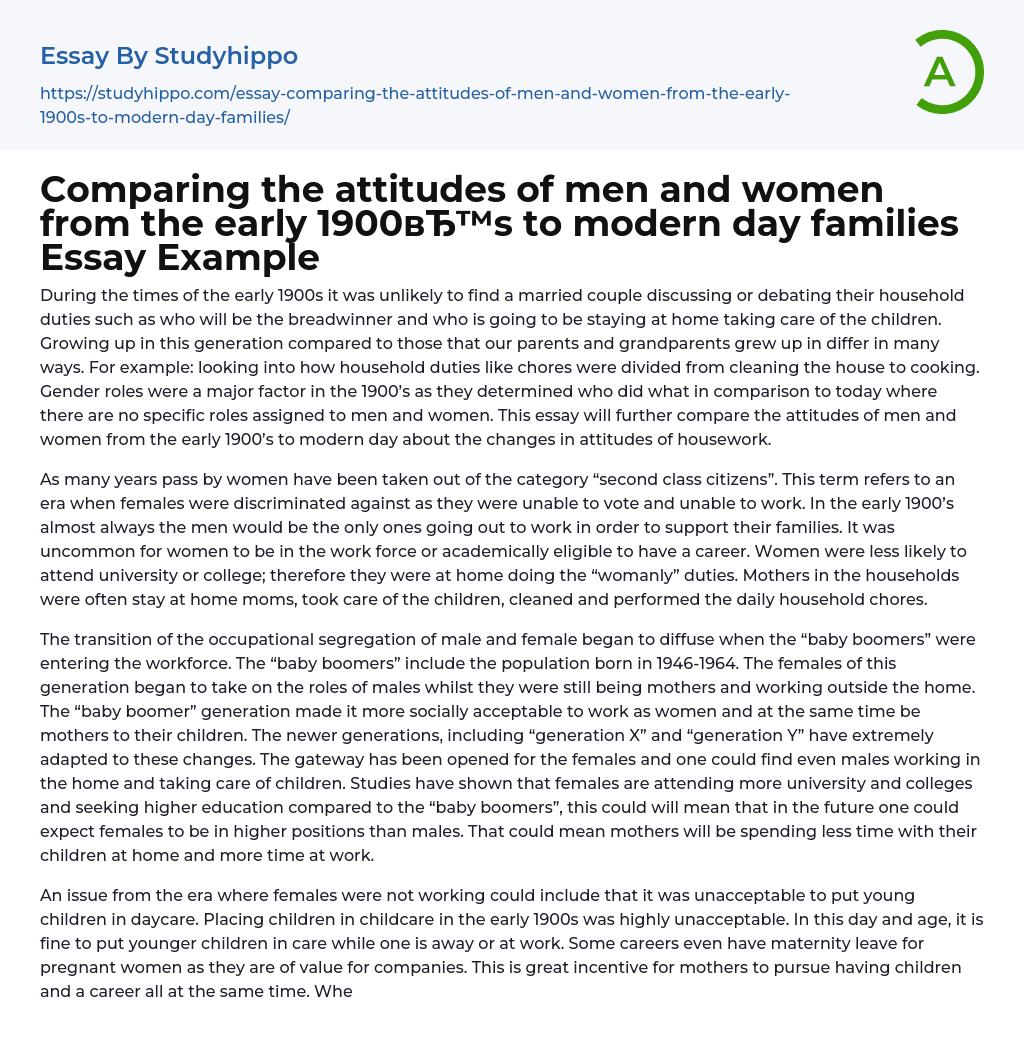During the times of the early 1900s it was unlikely to find a married couple discussing or debating their household duties such as who will be the breadwinner and who is going to be staying at home taking care of the children. Growing up in this generation compared to those that our parents and grandparents grew up in differ in many ways. For example: looking into how household duties like chores were divided from cleaning the house to cooking. Gender roles were a major factor in the 1900’s as they determined who did what in comparison to today where there are no specific roles assigned to men and women. This essay will further compare the attitudes of men and women from the early 1900’s to modern day about the changes in attitudes of housework.
As
...many years pass by women have been taken out of the category “second class citizens”. This term refers to an era when females were discriminated against as they were unable to vote and unable to work. In the early 1900’s almost always the men would be the only ones going out to work in order to support their families. It was uncommon for women to be in the work force or academically eligible to have a career. Women were less likely to attend university or college; therefore they were at home doing the “womanly” duties. Mothers in the households were often stay at home moms, took care of the children, cleaned and performed the daily household chores.
The transition of the occupational segregation of male and female began to diffuse when the “baby boomers” were entering
the workforce. The “baby boomers” include the population born in 1946-1964. The females of this generation began to take on the roles of males whilst they were still being mothers and working outside the home. The “baby boomer” generation made it more socially acceptable to work as women and at the same time be mothers to their children. The newer generations, including “generation X” and “generation Y” have extremely adapted to these changes. The gateway has been opened for the females and one could find even males working in the home and taking care of children. Studies have shown that females are attending more university and colleges and seeking higher education compared to the “baby boomers”, this could will mean that in the future one could expect females to be in higher positions than males. That could mean mothers will be spending less time with their children at home and more time at work.
An issue from the era where females were not working could include that it was unacceptable to put young children in daycare. Placing children in childcare in the early 1900s was highly unacceptable. In this day and age, it is fine to put younger children in care while one is away or at work. Some careers even have maternity leave for pregnant women as they are of value for companies. This is great incentive for mothers to pursue having children and a career all at the same time. When providing females with maternity leave and childcare it gives them great incentive to work and be apart of providing income for their families as well. Male and females at the same
time must create a balance between work and life, as they would not want to loose any valuable family time when placing children in childcare.
In conclusion, in the early 1900s it was socially acceptable for women not to go to work as they worked within the house. Today, it is acceptable for women to attend school and receive higher education. Men and women throughout the 1900’s had different roles in the household then men and women do in this era. Today, women seek job opportunities to equally provide for their families, as it is now the norm for dual income households. Females are now more visible in the workforce, and more dominate in universities than females in comparison to back in the early 1900s. Also, the “baby boomers” generation has made the transition from housewives to a working mother easier for the following generations. Furthermore, times have changed and women have evolved in terms of providing for families as well and taking a role outside of the home.
- Home essays
- Dog essays
- Adoption essays
- Babies essays
- Children essays
- Love essays
- Parenting Teens essays
- Wedding essays
- Wife essays
- Aunt essays
- Daughter essays
- Parents essays
- Sister essays
- Foster Care essays
- Sibling essays
- Father essays
- Grandparent essays
- Mother essays
- Caring essays
- Dysfunctional Family essays
- Bedroom essays
- Room essays
- Relationship essays
- Jealousy essays
- Friends essays
- Online Dating essays
- Divorce essays
- Husband essays
- Marriage essays
- Hometown essays
- Parenting essays
- Family Tradition essays
- Family Values essays
- Baby Clothes essays
- Child essays
- Childcare essays
- Child labor essays
- Doll essays
- Walls essays
- Appreciation essays
- Single Parent essays
- Single Parenting essays
- Feminism essays
- Animal Rights essays
- Animal Testing essays
- Bullying essays
- Abortion essays
- Abuse essays
- Immigration essays
- Poverty essays




